|
|
File
National Atestino Museum – Este
|
Via G. Negri 9/c – 35042 Este (PD)
– Fax 0429 603996 |
  |
|
Summary
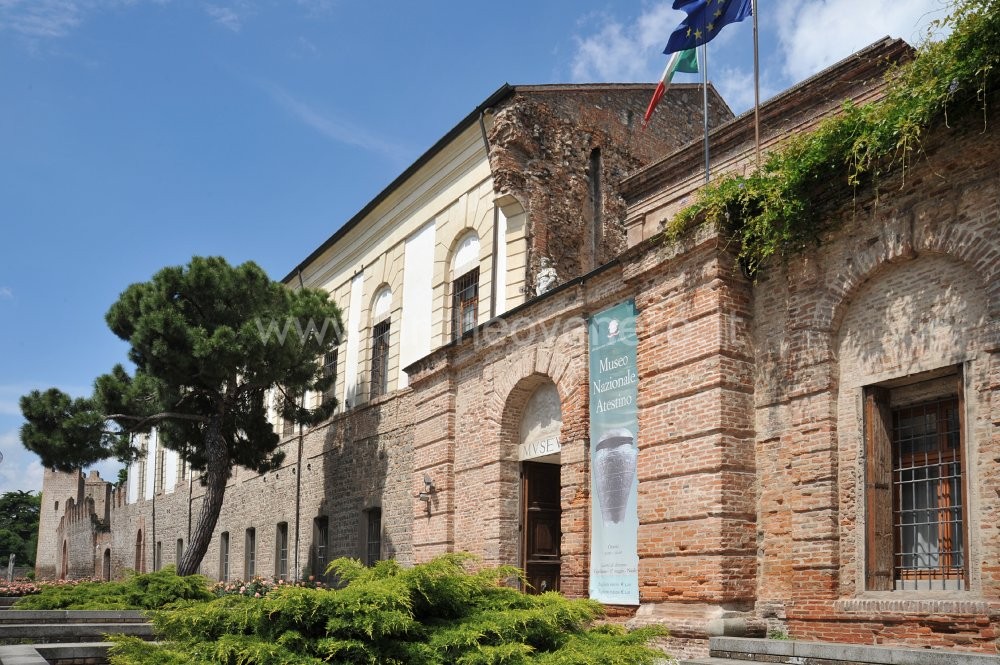
Since 1902 the National Atestino Museum is based in Palazzo Mocenigo erected at the end of 16th century. The façade encompasses a section of walls that used to surround the 13th century Carraresi castle. The rooms, numbered from I-XI (Roman numbering) and organised chronologically, lead us through various civilisations that occupied the centre of Este and the surrounding territories from most ancient times, through Roman Age, all the way to Medieval Age and Renaissance.
The tour begins in room I located at the main floor of the palace. This room is dedicated to prehistoric collection, from Palaeolithic at the end of Bronze Age, rooms II-V are dedicated to Veneto centre of Este (10th-3rd century A.D.) with its living areas, necropolises and sanctuaries. Rooms VI-X located on the ground floor hold the exhibits from the Roman centre of Ateste documenting public and private life, cults and funeral rituals.
In the last room there are some Medieval and Renaissance monuments, there is also a rich collection of ceramics, mainly from Atesta, from Medieval Age through to the beginning of the 20th century.
Collection history
The Museum was established in 1834 as Civil Lapidar Museum thanks to the initiative of Vincenzo Francanzani, then podestà. The first collection was created with the exhibits of Alessi and Contarini (mainly Roman inscriptions in stone and marble), held in the oratory of Santa Maria of Confraternita of Battuti inside the convent of San Francesco. As a result of some extraordinary findings in the pre-Roman necropolis in 1876 the museum changed its name to Euganeo-Roman Museum. Subsequently, on the Municipality of Este request, the museum became state property and changed its name to National Atestino Museum. It opened to public on the 6th of July 1902 in its current location of Mocenigo palace. Worth noticing are some original elements of the castle such as volte affrescate by Giulio Carpioni in the 17th century.
Closed in 1979 because of construction stability problems, the Museum was re-opened to public in 1984 with a new exhibition which covers the period from Palaeolithic to the Medieval-Renaissance Era and further into the 19th and 20th century. The exhibits come from pre-Roman and Roman centre of Este and the surrounding territory. Most of them were found during the excavation works carried out almost continuously from the last decades of the 19th century till today.
|

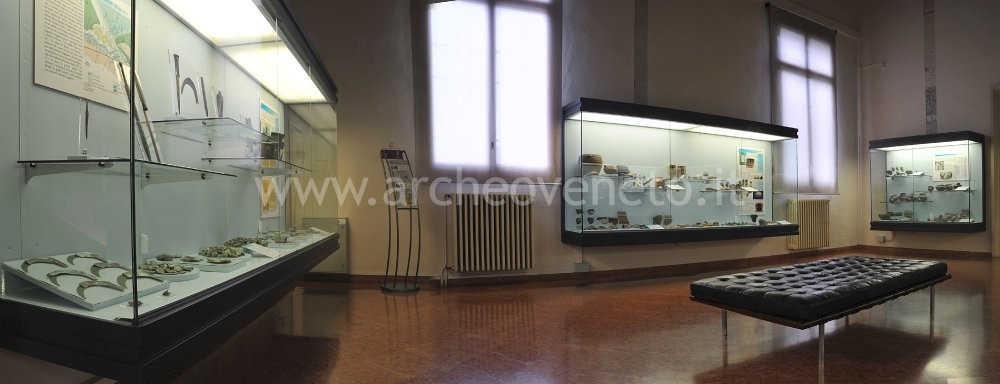 This room, located at the main floor of the palace is dedicated to the prehistoric collections. Flint artefacts confirm the oldest human presence on the western slopes of Colli Euganei during the Palaeolithic Era, whereas in the regions of Valcalaona (Baone) and Malandrina (Lozzo Atestino) there are signs of human existence from Mesolithic Era. There are some remarkable findings from the Neolithic Era, like those from antique Neolithic found in settlements of Le Basse in Valcalaona (Fioriano culture) as well as from Middle Neolithic in Maserà and Late Neolithic (the ‘culture of square rim vases’, ‘engraving and impression’ style). This room, located at the main floor of the palace is dedicated to the prehistoric collections. Flint artefacts confirm the oldest human presence on the western slopes of Colli Euganei during the Palaeolithic Era, whereas in the regions of Valcalaona (Baone) and Malandrina (Lozzo Atestino) there are signs of human existence from Mesolithic Era. There are some remarkable findings from the Neolithic Era, like those from antique Neolithic found in settlements of Le Basse in Valcalaona (Fioriano culture) as well as from Middle Neolithic in Maserà and Late Neolithic (the ‘culture of square rim vases’, ‘engraving and impression’ style).
In the same display cabinet you will find exhibits from the settlement of Castelnuovo di Teolo. These come from the end of the ‘square rim vases’ period and from the Copper Age.
The Copper Age is illustrated by individual findings from Este and some ceramic artefacts from Meggiaro area. The transition period between the Copper Age and Bronze Age is documented by the domestic pottery objects from Este-Ca’ Mori. Early and Middle Bronze Age are documented with some extensive material from Arquà Petrarca, a location on the shores of lake Laghetto della Costa whereas Late Bronze Age is illustrated by findings from Marendole (Monselice) and Lozzo Atestino. The material from the embankment locations of Casale di Scodosia/Vallerana and Montagnana-Borgo S. Zeno is quite rich (ceramics, bronze, stone artefacts); it also demonstrates how different the culture of that location was compared to that of the Sub-Apennine regions. The ample material found in riverside locations of Casale di Scodosia near Vallerana and Montagnana-Borgo S. Zeno (ceramics, bronze, stone artefacts) shows elements characteristic to terramaricoli and Sub-Apennine cultures.
Further down there are two displays of bronze exhibits from Merlara and Lozzo Atestino, dated from Late Bronze Age (13th century B.C.) and the transition period into Late Bronze Age (12th century B.C.) respectively. The tour ends with the presentation of bronze artefacts from the centre of Este.
|

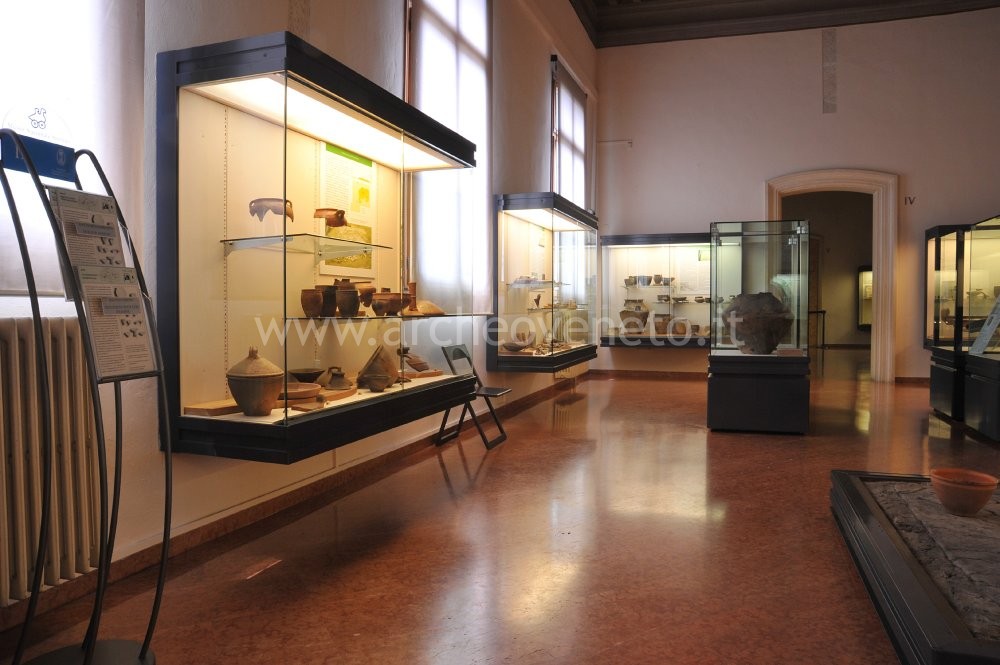 In this room you will find artefacts from the ancient Veneto centre of Este and from other settlements constructed in Agro Atestino around the same time. The community of Este-Borgo Canevedo established in Late Bronze Age (11th-10th century B.C.) in the proximity of the ancient Adige riverbed is documented by domestic use pottery (plates, bowls, cups, bowls, biconical vases, etc.), artefacts made of bone and horn (hoes, combs, handles) and bronze objects. As examples of women’s daily activities, there are whorls and looms, used for spinning and weaving as well as little horses and calves, all of which confirm the community’s involvement in sculpture production. In this room you will find artefacts from the ancient Veneto centre of Este and from other settlements constructed in Agro Atestino around the same time. The community of Este-Borgo Canevedo established in Late Bronze Age (11th-10th century B.C.) in the proximity of the ancient Adige riverbed is documented by domestic use pottery (plates, bowls, cups, bowls, biconical vases, etc.), artefacts made of bone and horn (hoes, combs, handles) and bronze objects. As examples of women’s daily activities, there are whorls and looms, used for spinning and weaving as well as little horses and calves, all of which confirm the community’s involvement in sculpture production.
The findings from Este-via Restara, a settlement from the 8th – 4th century B.C. shed more light on everyday life in those days. There is cooking and eating crockery, whorls and reels for textile activities, little mills in trachyte, etc. A mould for pendant production suggests the existence of some sort of metal production. On the floor there is a work plan made in terracotta from a laboratory house in via Restara. There are braziers and pieces of terracotta spits with end parts in the shape of Aries head. Vases in all sizes decorated with typical red and black stripes are fruits of thriving production of local ceramics. Numerous fragments of Attican ceramics indicate commercial exchange with Adriatic region (Spina and Adria).
The life of the centres spread around Padua low plain (between 11th and 9th century B.C.) is documented through a rich collection of pottery and objects made of bone/horn and bronze, originating from the large settlement of Montagnana-Borgo S. Zeno. A piece of vase made of Mycenaean ceramics and a small golden spiral of the same origin suggest that the area kept trading contacts with the western part of Mediterranean.
The life of the inhabitants of Veneto Atestino region is represented by a large range of domestic pottery from the settlement of Megliadino S. Fidenzio, locality Spin.
|

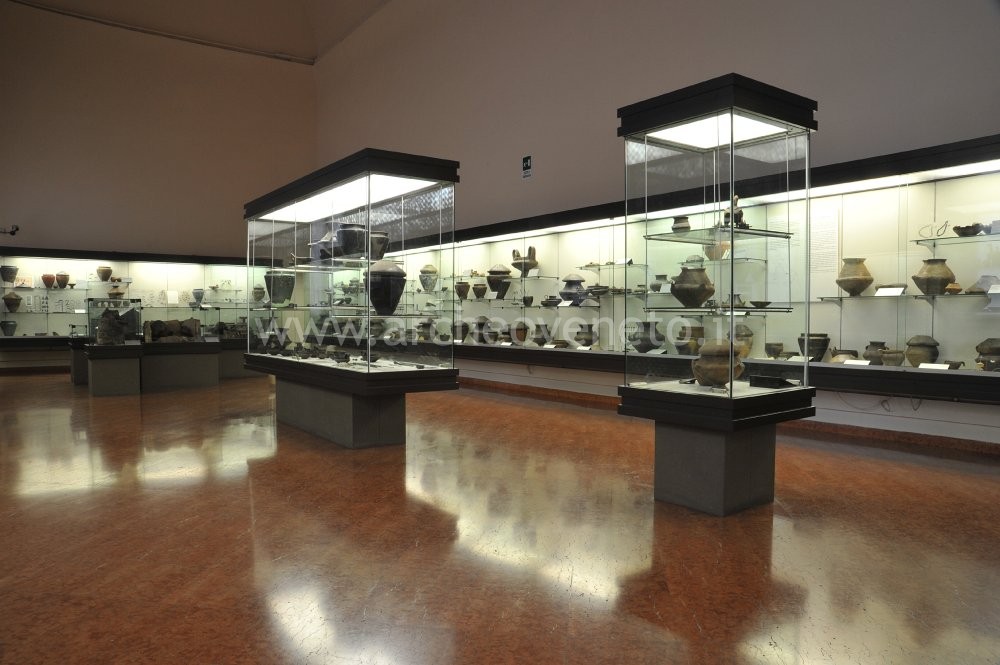 In this room there are grave goods and groups of objects from rich Atestine necropolises (10th – 3rd century B.C.). The last ones have the names of the owners of the places where they were found. In this room there are grave goods and groups of objects from rich Atestine necropolises (10th – 3rd century B.C.). The last ones have the names of the owners of the places where they were found.
Among the most ancient tombs (10th – 9th century B.C.) in the form of ‘vasi ossulari’ – vases with a cover accompanied by simple grave goods, usually in bronze, those of Prà d’Este and Este-fondo Pelà truly stand out. One of them is the famous vase in the form of a web-footed animal on wheels. Between the 8th and the 7th century B.C. together with the establishment of the ancient Veneto culture, the funeral ritual becomes more complex and the grave goods vary based on gender of the deceased. From the middle of the 8th century B.C., the evident social and economic differences are also reflected in the wealth and complexity of the grave goods. In that period the fine ceramics production for funeral use is initiated and the use of iron proliferates. From the end of the 7th century B.C., new decoration styles and techniques are developed, involving the designs of oriental animals, embossing and engraving. The first examples can be found on a bronze cup discovered in Benvenuti 122 tomb. At approximately the same time a bronze production technique called ‘situla art’ is developed, perhaps as a result of the arrival of bronzsmiths (from Bologna?). The undisputed masterpiece in this area has to be the situla from the female tomb Benvenuti 126, dated from around 600 B.C.
Between the 6th and 4th century B.C. the dominating decorating technique is that of red and black stripes with printed motives. The most frequent forms are bronze vases, glasses and cups. Among women’s adornments the most popular are brooches shaped as a winding arch, dragon, little boat and leech. From the end of the 6th century B.C. there is also a ‘Certosa’ brooch, named after the necropolis of Certosa near Bologna. The famous tombs of Boldù Dolfin no 52-53 come from the second half of the 4th century. Their discovery in 1876 has initiated the exploration works of the protohistoric necropolis.
There is numerous evidence for the existence of trade and social contacts with the Celtic culture: those can be found in the grave goods in Ricovero 226 tomb (silver earings), Benvenuti tomb 116 (a buckle in open-work iron), Benvenuti tomb 123 (bronze La Tène brooches, bronze and glass paste armillas, iron spade traditionally bent).
On the wall at the bottom of the room there is a series of grave stones in trachyte with inscriptions in Venetic language, dated between the 6th and 4th century B.C.
|

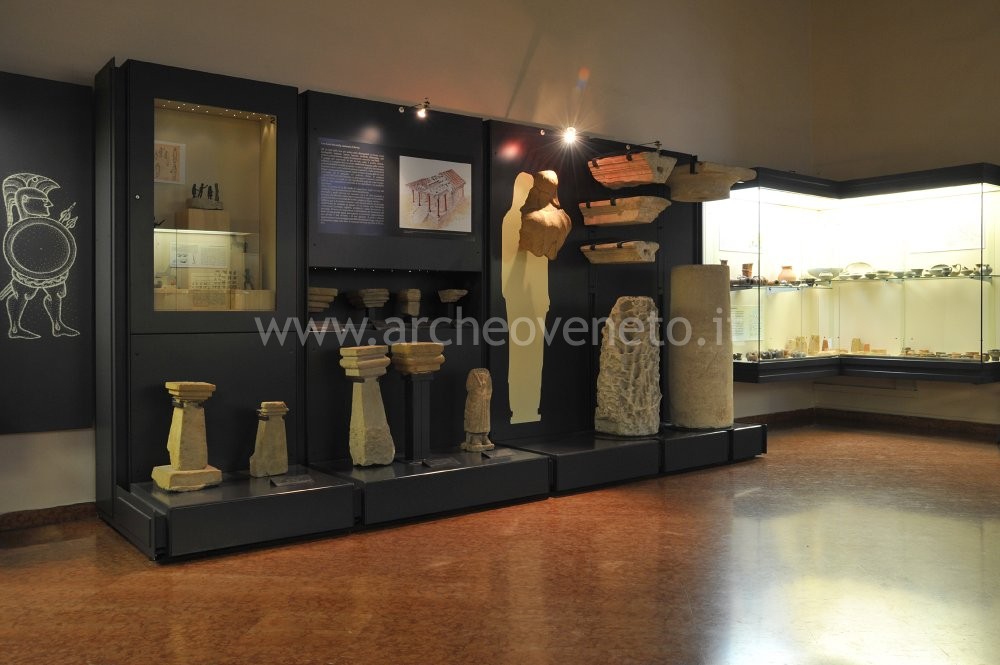 The room gathers exhibits from various areas of Este cult. The most important has to be the one dedicated to goddess Reitia, found in the ancient riverbed of Adige, around Baratella, and visited between the 7th century B.C. till the 2nd century A.D. There are numerous ex voto examples – bronze figures illustrating faith, war and divinities, anatomic figures representing the ‘healing’ aspect of divinity, bronze votive sheets (with embossed and imprinted decorations). There are also miniature cups and vases used for libation. Women’s everyday chores are illustrated by whorls and looms, used for spinning and weaving. The ‘alphabetic tablets’ and writing styluses suggest the existence of a learning centre writing situated in the shrine. From the Late Republican Roman period there are some architectural remains (columns, capitals, frames) and pieces of terracotta. The room gathers exhibits from various areas of Este cult. The most important has to be the one dedicated to goddess Reitia, found in the ancient riverbed of Adige, around Baratella, and visited between the 7th century B.C. till the 2nd century A.D. There are numerous ex voto examples – bronze figures illustrating faith, war and divinities, anatomic figures representing the ‘healing’ aspect of divinity, bronze votive sheets (with embossed and imprinted decorations). There are also miniature cups and vases used for libation. Women’s everyday chores are illustrated by whorls and looms, used for spinning and weaving. The ‘alphabetic tablets’ and writing styluses suggest the existence of a learning centre writing situated in the shrine. From the Late Republican Roman period there are some architectural remains (columns, capitals, frames) and pieces of terracotta.
The other group of findings, dated from the 5th century B.C. till the Roman Age, has its origins in a cult centre located in the area of Caldevigo. It is here that the so-called ‘goddess of Caldevigo’ comes from. It is represented by a typically dressed woman (high boots and a large belt) wearing rich necklaces and bracelets.
Among the ‘votiva stipe’ found in the locality of Morlungo there are bronze ex voto presenting female and male sex organs and dedicated to the goddess of fertility.
|

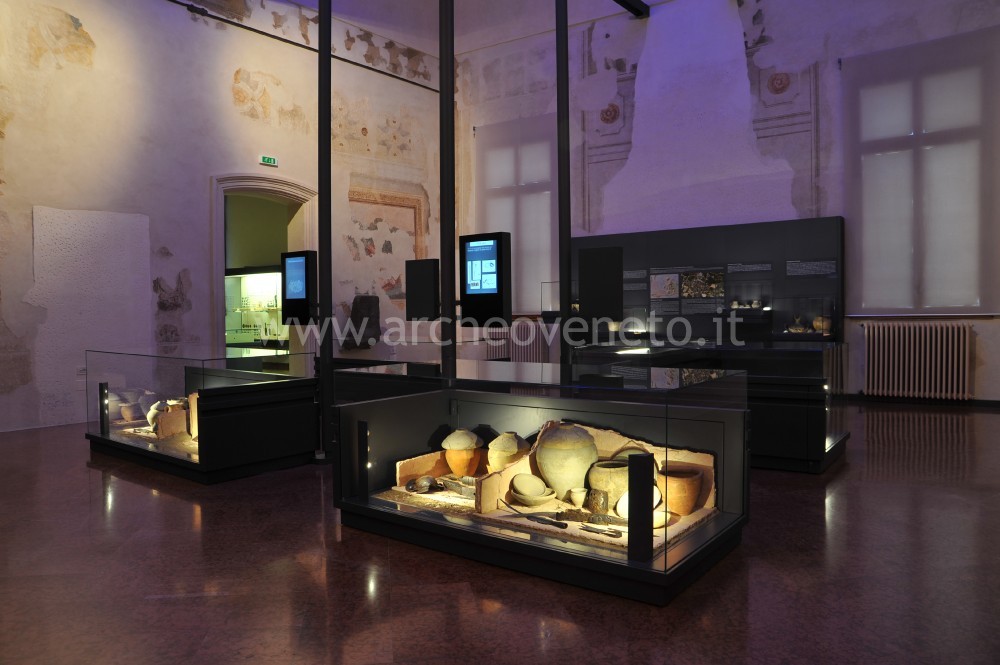 This room is dedicated to the funeral findings from the Atestino territory. This room is dedicated to the funeral findings from the Atestino territory.
The oldest part of it is represented by grave goods found in tombs in Montagna – Borgo S. Zeno. The graves come from the period between the end of Bronze Age and the beginning of Iron Age (10th – 8th century B.C.). A grave of a woman buried together with a foetus and adorned with bronze earrings is of particular interest.
Among the tombs with cremated bodies from Saletto – Fondo Besola, dated from the 7th till the 5th century B.C., there is one that stands out: a female grave with various adornments among which an amber pearls necklace.
The contents of the tombs from Arquà Petrarca (cremated) confirm the continuation of local traditions as well as some Celtic and Roman influences.
|

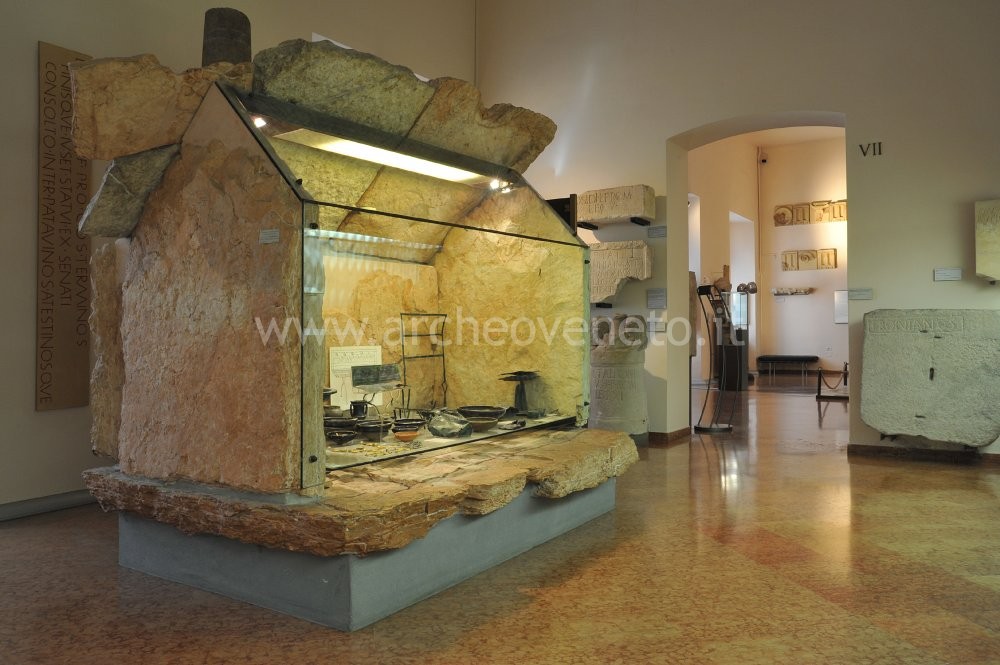 This room presents the monumental tomb entitled ‘Casa di Ricovero 23’, dated from the first half of the 3rd century B.C. Its construction is somewhere between a sarcophagus and a room-style tomb in Etruscan style. The tombs location is out of chronological order because of its large dimensions. The high rank of the deceased is confirmed not only by rich grave goods but also by the name, Nerka Trostiaia, engraved on the edge of the bronze situla. This room presents the monumental tomb entitled ‘Casa di Ricovero 23’, dated from the first half of the 3rd century B.C. Its construction is somewhere between a sarcophagus and a room-style tomb in Etruscan style. The tombs location is out of chronological order because of its large dimensions. The high rank of the deceased is confirmed not only by rich grave goods but also by the name, Nerka Trostiaia, engraved on the edge of the bronze situla.
Other exhibits illustrate the transition phase from ancient Venetian to Roman civilisation. The border stones from Galzignano and Monte Venda (114 or 116 B.C.) suggest the interference of Roman Senate in setting the borders between the Atestini and Patavini. Another important document is the tabula Atestina (or Atestinum Fragmentum), the law written on a bronze sheet and dated from the first decades of the 1st century B.C. The law relates to the competences of local magistrates within the area of Gallia Cisalpina.
The transition from the Venetic language to Latin is documented on the tombstones as well as on numerous inscriptions on the urns (like those on Titinii family tomb).
|

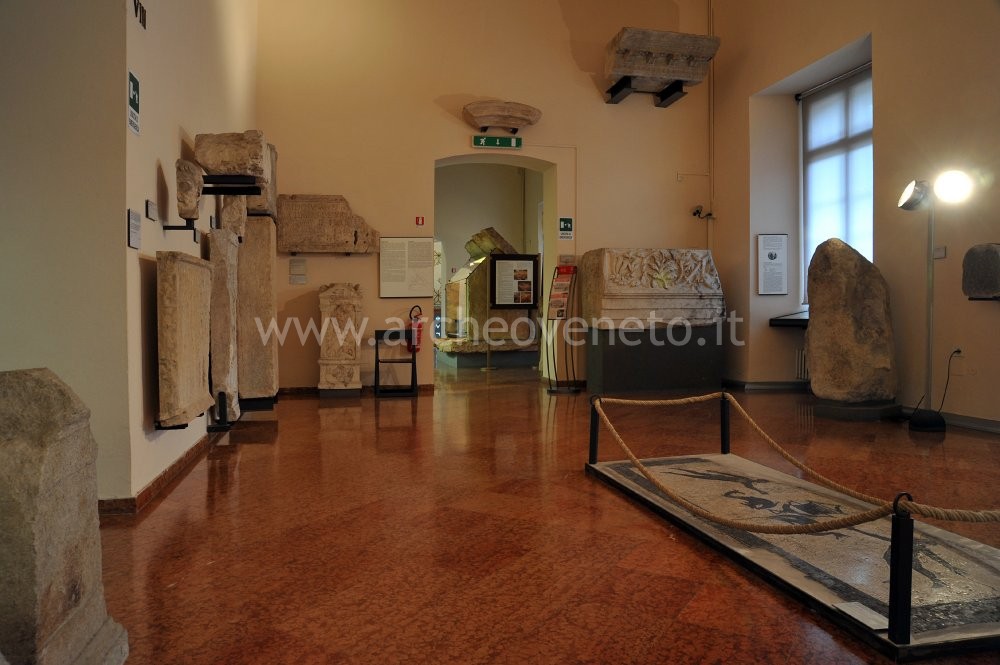 Various kinds of inscriptions and reliefs provide valuable information about Ateste public administration and the gods worshiped. On the wall at the bottom of the room there is a reconstruction of a terracotta decoration (composed of triglyphs and metopes), which adorned the façade of a temple dedicated to a worshiped couple, probably the Dioscuri. The temple was raised in the area currently called Casale, an ancient riverbed of Adige. It is the oldest part of the shrine, still from the Iron Age, that a small bronze cup with a Venetian inscription is related to. Various kinds of inscriptions and reliefs provide valuable information about Ateste public administration and the gods worshiped. On the wall at the bottom of the room there is a reconstruction of a terracotta decoration (composed of triglyphs and metopes), which adorned the façade of a temple dedicated to a worshiped couple, probably the Dioscuri. The temple was raised in the area currently called Casale, an ancient riverbed of Adige. It is the oldest part of the shrine, still from the Iron Age, that a small bronze cup with a Venetian inscription is related to.
Worship objects found in the Roman temple (mainly metal artefacts dedicated to navigation, trade, fishing, health and fertility), document the activity of the shrine till the end of the 2nd century A.D. Another aspect of the public life in the Roman times is documented by a display of coins from the Republican and Imperial Age, with a rare golden medallion from Augustan emission in 2 B.C.
|

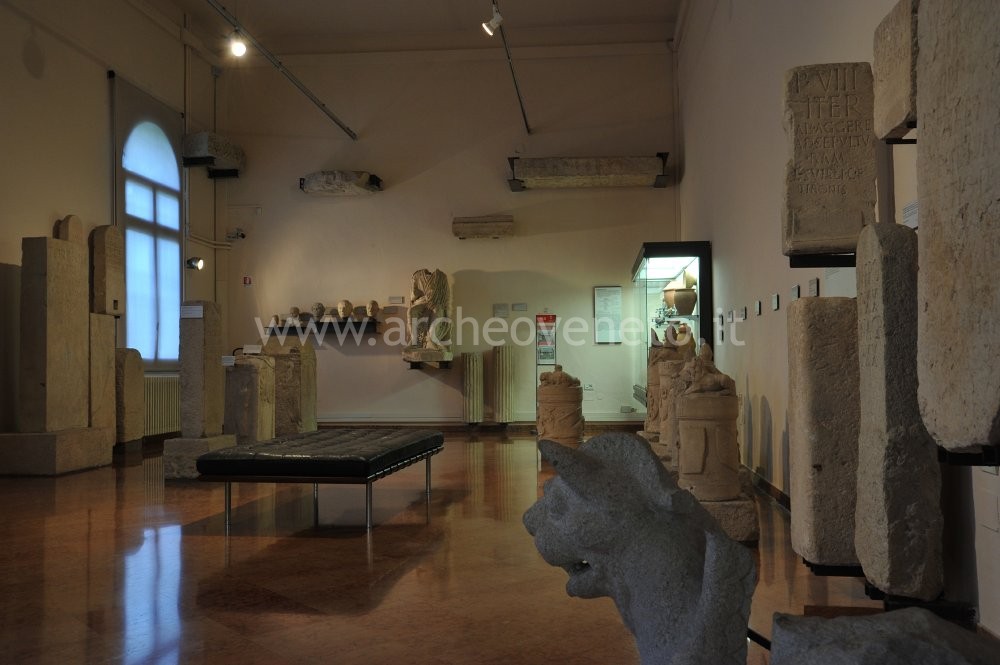 The Roman necropolises come from the period between the Augustan Age and the 2nd century A.D. The dominating ritual is by far the cremation, which used to be performed till at least the beginning of the 2nd century A.D. when the traditional burial ceremony took over as a result of new religious practices. The Roman necropolises come from the period between the Augustan Age and the 2nd century A.D. The dominating ritual is by far the cremation, which used to be performed till at least the beginning of the 2nd century A.D. when the traditional burial ceremony took over as a result of new religious practices.
In this room a small cemetery from the 1st century A.D. has been reconstructed. It was found in Rebato property and it was here that the slaves and freedmen of important families like the gens Arria were buried. The stones of the first ring of the cemetery were used as sacrifice altars, in the second ring there were 150 tombs, some quite monumental. Apart from the usual grave goods items there is a lead sheet with a curse inscription (defixio). Following there is a large display of monuments found in Este and in the neighbourhood, divided in categories. Among the grave goods there is one set that must have belonged to a doctor as it contains medical instruments (scalpels, ear-picks, probes, tweezers; Capodoglio IX tomb)
A statue located on the wall at the bottom of the room and presenting a person dressed in Prà d’Este toga was also most likely one of the grave goods objects.
|

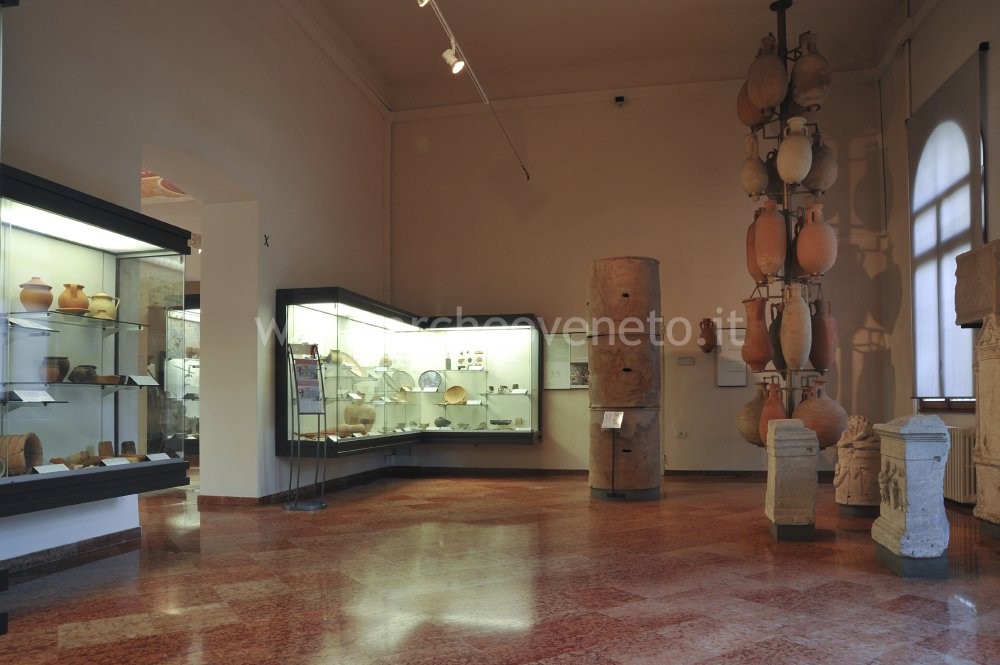 The arts and professions are presented on the monuments, mostly funeral, presented in the area between the windows. Among the craftsmen there is a shoemaker, a boilermaker, two carders, a cook; among professionals there is a doctor and a soldier. The shapes of the amphoras found in Este and around it indicate what kind of food people used to eat, some local and some imported from Istria, southern Italy (wine), Spain (oil and fish sauce in the 1st century A.D.) and Africa (2nd century A.D.). The arts and professions are presented on the monuments, mostly funeral, presented in the area between the windows. Among the craftsmen there is a shoemaker, a boilermaker, two carders, a cook; among professionals there is a doctor and a soldier. The shapes of the amphoras found in Este and around it indicate what kind of food people used to eat, some local and some imported from Istria, southern Italy (wine), Spain (oil and fish sauce in the 1st century A.D.) and Africa (2nd century A.D.).
The exhibits presented in the display cabinets illustrate both the architectural structure of the houses as well as the domestic activities and works. There are pans, elements of architectural decoration, wall plasters, locks and keys, parts of candleholders and lamps. Household activities are also documented by kitchenware, tableware and bronze cutlery. Large quantity of weights, reels, whorls suggest involvement in weaving and spinning.
Excavation works carried out in the ancient district of Este close to the civil hospital have shed even more light on life in the pre-Roman and Roman Age.
|

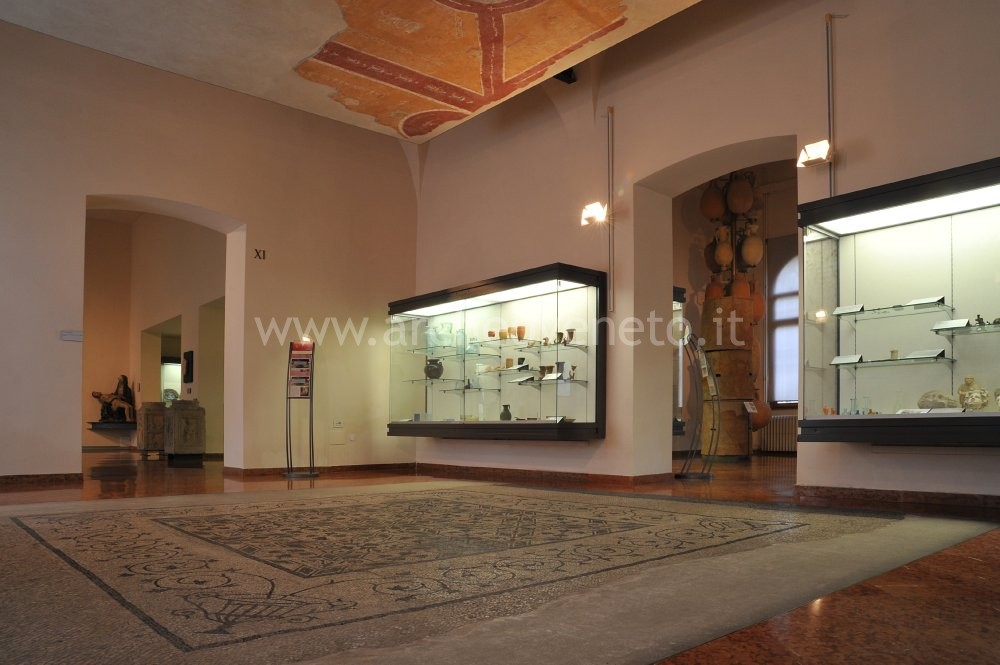 This room hosts further objects related to some aspects of private life in Este in the Roman Age (adornment objects, toiletries, glass and terracotta balm containers). Among household exhibits there is a large collection of cooking pottery in terracotta, bronze and glass. As examples of local craftsmanship there are bronze figures representing mainly female divinities (Iside-Fortuna, Minerva, Venere, Diana, etc.). This room hosts further objects related to some aspects of private life in Este in the Roman Age (adornment objects, toiletries, glass and terracotta balm containers). Among household exhibits there is a large collection of cooking pottery in terracotta, bronze and glass. As examples of local craftsmanship there are bronze figures representing mainly female divinities (Iside-Fortuna, Minerva, Venere, Diana, etc.).
From the centre of Abano Terme comes a group of drinking vases in glassed-ceramics in the shape of a corn with the end part sculptured into horse protome.
The most famous artefact has to be a large ceiling fragment, painted a fresco, reconstructed and placed approximately at its original height. It was previously located in a large representative room (14,60m x 7,85m) of a luxurious Roman domus and discovered in 1937 in Serraglio Albrizzi part of Este. The colour scheme (yellow-ochre, dark red, black and azure-blue) and the use of particular decoration elements suggest that the fresco painting was performed around Hadrian’s Age.
|

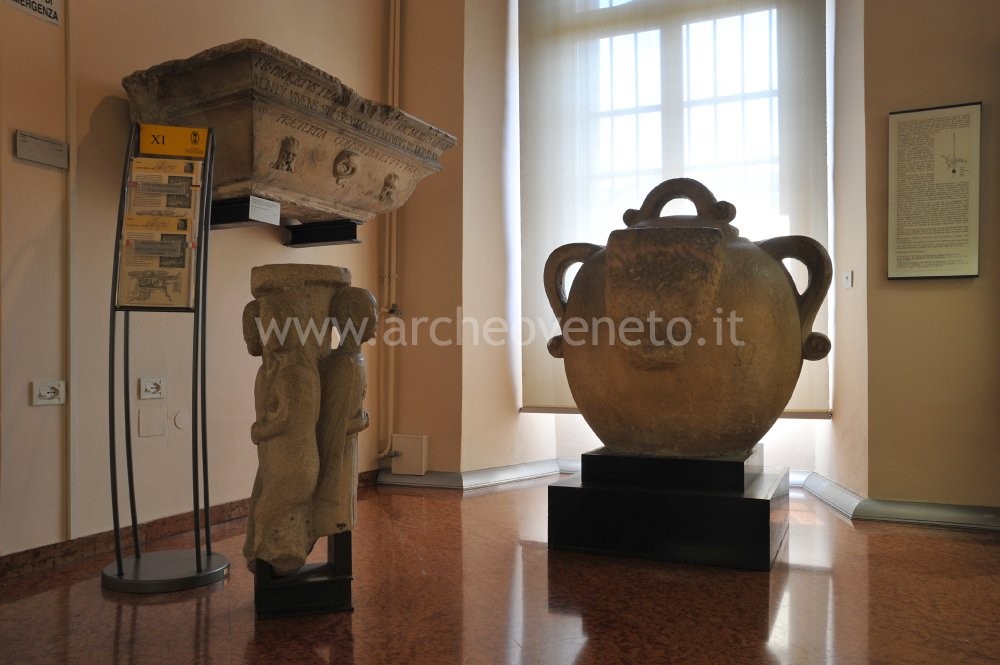 This room located on the ground floor concludes the tour. Here you will find architectural pieces and furnishings from demolished churches and houses of Este and the surrounding area. Worth noticing is a railing decorated with Christian peacock motives (8th century), wooden Pietà in German school (14th century), but most of all a table representing Madonna with baby Giovan Battista Cima from Conegliana, realised for the Convent of Saint Mary in Este in 1504. This room located on the ground floor concludes the tour. Here you will find architectural pieces and furnishings from demolished churches and houses of Este and the surrounding area. Worth noticing is a railing decorated with Christian peacock motives (8th century), wooden Pietà in German school (14th century), but most of all a table representing Madonna with baby Giovan Battista Cima from Conegliana, realised for the Convent of Saint Mary in Este in 1504.
In the display cabinet on the right there is a vast collection of generic ceramics produced or sold in Este territory between the 13th and 19th century. The core of the collection is constituted by a series of majolica ‘berrettine’ and compendiarie from Veneto and Faentina produced between the 1579 and 1600.
As far as the Atestina ceramics is concerned worth pointing out are the products of Franchini manufacture (end of 18th century) and Brunello and Contiero (second half of the 18th century and first decades of the 19th century).
|
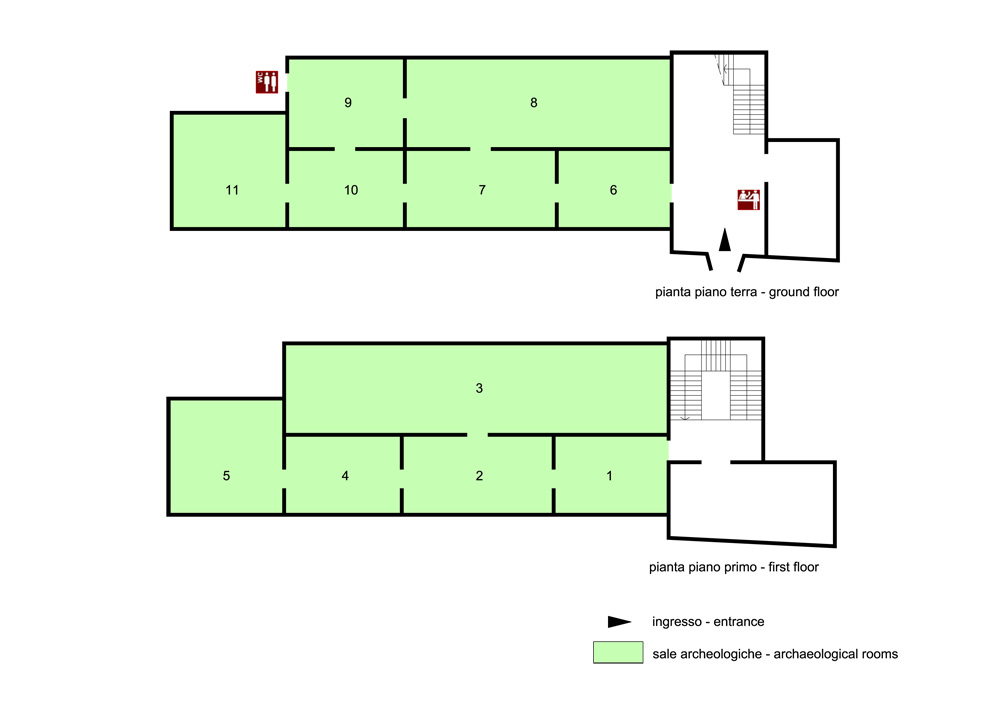
Admission: Negli orari di apertura
Ticket: Si
Price: Full price € 4; reduced price € 2 (EU citizens aged between 18-25); free entrance (EU citizens under 18 and over 65, schools)
 School access School access
 Disabled access Disabled access
Opening Days
| Tipology |
When |
Specs |
| Summer/Winter |
Monday |
8.30 – 19.30 |
| Summer/Winter |
Tuesday |
8.30 – 19.30 |
| Summer/Winter |
Wednesday |
8.30 – 19.30 |
| Summer/Winter |
Thursday |
8.30 – 19.30 |
| Summer/Winter |
Friday |
8.30 – 19.30 |
| Summer/Winter |
Saturday |
8.30 – 19.30 |
| Summer/Winter |
Sunday |
8.30 – 19.30 |
Closed on New Year’s Day, 1st May and Christmas Day. The ticket office closes at 7pm.
Recommended tour time (minutes): 120
 Toilet Toilet
 Bookshop Bookshop
 Rest points Rest points
in each room there is at least 1 chair
 Guide a stampa Guide a stampa
Brochure
Brochure anche in inglese e tedesco
 Information boards Information boards
Italiano
 Mobile cards Mobile cards
French, German, English
 Captions under exhibits Captions under exhibits
Italiano
 PC learning points PC learning points
At the entrance you can find a PC for a virtual tour of the museum
 Multilingual ads: Francese Multilingual ads: Francese
Tedesco
Inglese
 Guided Tours Guided Tours
Booking required, organised by Studio D: tel. 049 8360553, 348 2858309; e-mail: info@studiodarcheologia.it
 Educational activities Educational activities
Booking required, organised by Studio D: tel. 049 8360553, 348 2858309; e-mail: info@studiodarcheologia.it
 Educational workshops Educational workshops
Booking required, organised by Studio D: tel. 049 8360553, 348 2858309; e-mail: info@studiodarcheologia.it
 Library and documentation centre Library and documentation centre
Admission upon request
 Other activities Other activities
all-purpose room
| Prosdocimi A. 1902, Brevi cenni del Museo Nazionale Atestino in Este: ex Museo Civico, Este. |
| Callegari A. 1937, Il Museo Nazionale Atestino in Este, Roma. |
| Fogolari G. 1957, Il Museo Nazionale Atestino in Este, Roma. |
| Fogolari G., Prosdocimi A.L. 1988, I Veneti antichi. Lingua e cultura, Padova. |
| Capuis L. 1993, I Veneti. Società e cultura di un popolo dell’Italia preromana, Milano. |
| Chieco Bianchi A.M. 1999, Museo Nazionale Atestino. Este, Roma. |
| 1902-2002. Il Museo di Este: passato e futuro 2002, a cura di Chieco Bianchi A.M., Ruta Serafini A., Treviso. |
| I Veneti dai bei cavalli 2003, a cura di Malnati L., Gamba M., Treviso. |
| Musei e raccolte archeologiche del Veneto 2004, a cura di Di Mauro A., Dosson di Casier, pp. 53-58. |
| Tagliaferro C. 2006, Anelli e gemme del Museo Nazionale Atestino, in Quaderni di Archeologia del Veneto, XXII, pp. 167-173. |
| Bolla M. 2008, Bronzi figurati romani del Museo Nazionale Atestino, in Aquileia Nostra, LXXIX, pp. 33 – 120. |
| Bonetto J. 2009, Veneto (Archeologia delle Regioni d’Italia), Roma, pp. 401-406. |
|

